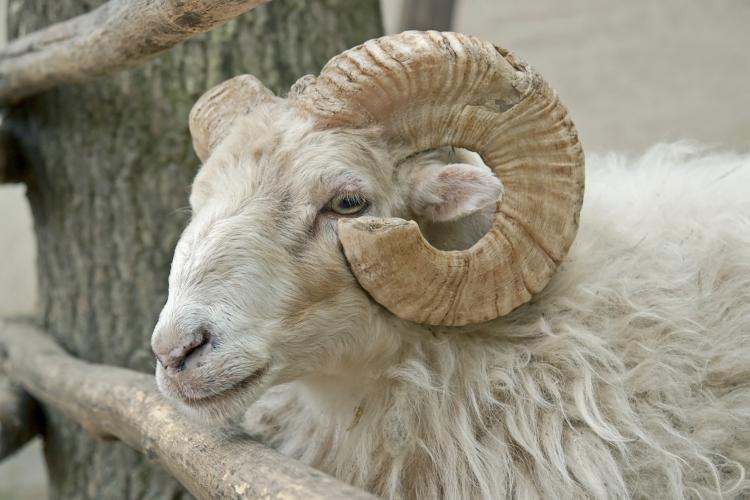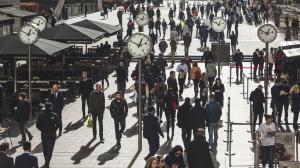
Best Comet of 2025?
C/2024 G3 (ATLAS) has already become very faintly visible to the naked eye for observers in the Southern Hemisphere.
The Sacrifice Feast in Turkey is a four-day religious festival. The Sacrifice Feast traditions in Turkey include sacrificing an animal in a special ritual, visiting relatives and helping the poor.
Sacrifice Feast is a public holiday. It is a day off for the general population, and schools and most businesses are closed.

The ram is an important symbol for the Sacrifice Feast in Turkey.
©iStockphoto.com/prill
The Sacrifice Feast is one of the oldest Islamic holidays in Turkey. It commemorates the story about Prophet Ibrahim (Abraham) who showed obedience to God by agreeing to sacrifice his son. God then sent him a ram to be sacrificed instead. The Sacrifice Feast comes about 70 days after the Ramadan Feast. According to old belief it is unlucky to get married or start a new business in the period between these two holidays.
Traditionally, on the first day of the Sacrifice Feast in Turkey, men of each family go to a mosque for a special morning prayer. Then the sacrifice ritual begins. In some regions in Turkey, people paint the sacrificial animal with henna and adorn it with ribbons. The butcher reads a prayer before slaughtering the animal. Families share about two-thirds of the animal’s meat with relatives and neighbors, and they traditionally give about one-third to the poor.
In recent years, some Turkish people started making donations to charity organizations instead of sacrificing animals. Many people in Turkey take special care to help the poor during the Sacrifice Feast.
People usually wear their best clothes during the Sacrifice Feast. They welcome guests to their homes or visit relatives or friends during the holiday. Many people in Turkey reserve the first day of the feast for visiting their closest relatives. Young people greet their older relatives and neighbors by kissing their hand as a sign of respect. Some people in Turkey may use the four-day holiday to go on a vacation.
The Sacrifice Feast is an official four-day holiday in Turkey. Administration buildings, schools, banks and post offices are usually closed during this period. Supermarkets remain open, but may work on a special holiday schedule.
Public transport may run less frequently during the Sacrifice Feast, and fares are usually lower compared to regular days. Highways may be overcrowded due to holiday travel. Because the beginning of the Sacrifice Feast coincides with the end of Hajj, the annual pilgrimage to Mecca, both domestic and international travel in Turkey may be intense during this period.
The Sacrifice Feast takes place in the four days following the 10th day of the Islamic month of Dhu al-Hijja. The exact dates are determined using the Islamic calendar, whose months begin with the first sighting of a new moon. The Islamic calendar begins its count from 622 CE, the year in which Prophet Muhammed (the Turkish spelling) moved from Mecca to Medina. This calendar has been in use since about 640 CE.
The common symbols of the Sacrifice Feast in Turkey are a ram (or a sheep) and a mosque.
| Year | Weekday | Date | Name | Holiday Type |
|---|---|---|---|---|
| 2020 | 金曜日 | 7月31日 (金) | Sacrifice Feast | National Holiday |
| 2021 | 火曜日 | 7月20日 (火) | Sacrifice Feast | National Holiday |
| 2022 | 土曜日 | 7月9日 (土) | Sacrifice Feast | National Holiday |
| 2023 | 水曜日 | 6月28日 (水) | Sacrifice Feast | National Holiday |
| 2024 | 日曜日 | 6月16日 (日) | Sacrifice Feast | National Holiday |
| 2025 | 金曜日 | 6月6日 (金) | Sacrifice Feast (Tentative Date) | National Holiday |
| 2026 | 水曜日 | 5月27日 (水) | Sacrifice Feast (Tentative Date) | National Holiday |
| 2027 | 日曜日 | 5月16日 (日) | Sacrifice Feast (Tentative Date) | National Holiday |
| 2028 | 金曜日 | 5月5日 (金) | Sacrifice Feast (Tentative Date) | National Holiday |
| 2029 | 火曜日 | 4月24日 (火) | Sacrifice Feast (Tentative Date) | National Holiday |
| 2030 | 土曜日 | 4月13日 (土) | Sacrifice Feast (Tentative Date) | National Holiday |
While we diligently research and update our holiday dates, some of the information in the table above may be preliminary. If you find an error, please let us know.

C/2024 G3 (ATLAS) has already become very faintly visible to the naked eye for observers in the Southern Hemisphere.

How does the 12-hour clock system work? Is midnight 12 am or 12 pm?

Why do many countries set the clocks back and forth an hour twice a year?

Why are there 12 months? How long are they, and what do the month names mean?